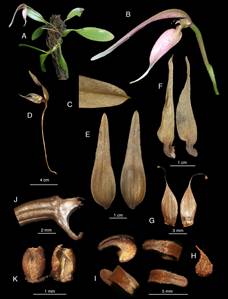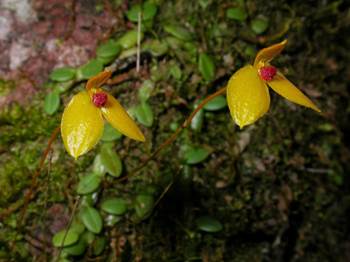Introduction
The genus Bulbophyllum Thouars is one of the largest plant genera, with well over 2000 species in the tropics and subtropics worldwide (Pridgeon et al. 2014). So far, about 145 species in 16 sections have been recorded for Vietnam (Averyanov & Averyanova 2003, Nong & Averyanov 2015, Averyanov et al. 2016, Truong & Sridith 2016, Averyanov et al. 2017, Nguyen & Averyanov 2017, Averyanov et al. 2018, Truong et al. 2019a, 2019b, 2019c, Averyanov et al. 2019a, 2019b).
During the botanical survey in Hon Ba Nature Reserve (Khanh Hoa Province, Vietnam), we found two Bulbophyllum species not previously reported from Vietnam, B. leysianum Burbidge, of section Hyalosema and B. ovalifolium Lindl., of section Macrocaulia.
Materials and methods
We took photos of the plants with a Canon 600D fitted with an EF-S 60mm f/2.8 Macro USM lens. We preserved material of both species in 70% ethanol; the samples are stored in VNM (Institute of Tropical Biology Herbarium). The descriptions below are based on the plants found in Hon Ba Nature Reserve. Terminology for the morphological description follows Beentje (2012) and Vermeulen et al. (2015).
Taxonomic treatment
Bulbophyllum leysianum Burb., J. Roy. Hort. Soc. 17.1895; Vermeulen et al., Orchid of Borneo: 607, fig. 726, 727, 728. 2015. (Fig. 1).
TYPE: Malaysia. Sabah: Sinaroup Village, Burbidge s.n. (not seen).
Long-creeping epiphyte. Rhizome ca. 3 mm in diameter, sections between pseudobulbs 0.6-1.5 cm long. Pseudobulbs 1-leafed, glossy green, obliquely ovoid, 1.1-2.0 cm long, 0.5-1.3 cm wide. Leaves green, thick, narrowly elliptic, 6-9 cm long, 2.2-3.0 cm wide, apex obtuse; petiole ca. 2 cm long. Inflorescence from mature pseudobulbs, 1-flowered, ca. 18 cm long, peduncle ca. 7.4 cm long, bracts 4, 3-8 mm long, apex acute. Flowers slightly to moderately opening, dorsal sepal white, suffused pink, greenish around the midvein and towards the base, lateral sepals white, suffused pink, petals white with green veins and pink appendage, lip white, suffused pink, slightly greenish abaxially, and with patches of pink-red spots; pedicel plus ovary ca. 2.7 cm long, floral bract tubular, ca. 11 mm long. Dorsal sepal concave towards the base, narrowly ovate, ca. 5.5 cm long, 1.6 cm wide, apex rounded and mucronate, margins entire, ciliolate, surface almost glabrous, abaxially keeled along the midvein; ca. 12- veined. Lateral sepals loosely adherent along the lower margins, upper margin curved inwards until it (almost) touches the upper margin of the opposite sepal, flat, obliquely ovate-triangular, clawed, 4.0-4.2 cm long, 7-8 mm wide above the claw, apex acute, margins entire; glabrous, ca. 10-veined. Petals obliquely elliptic, ca. 7 mm long, 2 mm wide, apex with a ca. 3 mm long filiform processus ending with a globular, warty apex; margins entire; glabrous, 3-veined. Labellum fleshy, curved in lateral view, (elliptic-) oblong, ca. 5 mm long, 1.8 mm wide, apex rounded, margins ciliate, adaxially slightly concave towards the base, elsewhere with a shallow median furrow which ends just short of the slightly convex apex, surface almost glabrous towards the base, elsewhere hirsute, shorter so towards the apex, abaxially almost glabrous, abaxially with a distinct keel, surface glabrous. Column ca. 2.8 mm long; stelidia short, triangular, acute, with a small, antrorse, acute tooth along the upper margin, and deltoid, obtuse tooth along the lower margin. Anther cap with the frontal margin drawn out into a widely rounded beak.

Photos by Truong B. V., 2018.
Figure 1 Bulbophyllum leysianum Burb. A. Flowering plant. B. Flower, side view. C. Leaf apex. D. Flower with pedicel and peduncle. E. Dorsal sepal. F. Lateral sepals. G. Petals. H. Warty apex of petal. I. Labellum, different views. J. Column. K. Anther cap. (Truong B.V., BV 340, Hon Ba, Khanh Hoa province, Vietnam).
Ecology and phenology: Epiphyte on small branches along a stream over granite bedrock, ca. 400 m a.s.l. Very rare in Hon Ba reserve. Flowering in November.
Distribution: Peninsular Malaysia, Borneo, Java. This species has been known only from Malesia and hence its occurrence in Vietnam shows a very disjunct distribution range.
Material examined: VIETNAM. Khanh Hoa Province: Hon Ba Nature Reserve, 8 November, 2018, Truong Ba Vuong, Mang Van Lam BV 340 (VNM 00023601); Khanh Hoa Province, Hon Ba Nature Reserve, 19 February, 2019, Truong Ba Vuong, Mang Van Lam BV 350 (VNM 000023603)
This species may be confused with B. antenniferum (Lindl.) Rchb.f., which has been reported from Peninsular Malaysia and peninsular Thailand (Vermeulen et al. 2015). Bulbophyllum leysianum differs by the nearly oblong, adaxially coarsely hirsute labellum of less than 2 mm wide (vs. labellum ovate-triangular, adaxially finely hirsute only in the centre and otherwise glabrous, and more than 2 mm wide in B. antenniferum).
Bulbophyllum ovalifolium (Blume) Lindl., Gen. Sp. Orchid. Pl.: 49. 1830; Seidenf. & Wood, Orch. Malay. Sing.: 513, fig. 234, a-j. 1992; Vermeulen et al., Orchid of Borneo: 552, fig. 669, 670, 671, 672, 673. = Diphyes ovalifolia Blume, Bijdr. Fl. Ned. Ind.: 318. 1825. = Phyllorkis ovalifolia (Blume) Kuntze, Revis. Gen. Pl. 2: 677. 1891. (Fig. 2)
TYPE: Indonesia: Java, Mount Gedeh, Blume 509, HLB 902, 322-463 (L! L0058263).
Small, creeping, epiphyte on branches orchid. Rhizomes ca. 0.5 mm in diameter. Pseudobulbs 1-leafed, ovoid, narrowly elliptic, ca. 6 mm long. Leaves 1-leafed, elliptic ca. 9.5 mm long, 5 mm wide, obtuse, petiole ca. 1.5 mm long. Inflorescence orange color, from base of mature pseudobulbs, 1-flowered, ca. 1.5 cm long, usually from pseudobulbs without leaves, floral bract, tubular, ca. 1 mm long. Flower open widely, tepals orange, labellum red, column red. Dorsal sepals elliptic, ca. 3 mm long, 2 mm wide, subacute and minutely apiculate, margins entire, glabrous, 5-veined. Lateral sepals elliptic, ca. 4.5 cm long, 2.5 cm, rounded, margins entire, glabrous, 5-veined. Petals elliptic, ca. 1.5 mm long, 0.5-0.6 mm wide, obtuse, margins entire, glabrous, 1-veined. Labellum simple, attached to the column foot by white ligament, recurved proximally, elliptic, ca. 2.1 mm long, 1.2 mm wide, margin distally folded downward, abaxial surface concave and glabrous proximally, convex and coarsely verruculose distally. Column ca. 0.3 cm long, column foot ca. 1 mm long, stigma elliptic; stelidia ca. 0.8 mm long, triangular subulate, slightly downwards curved, acute. Pollina 4. Anther cap not seen.
Ecology and phenology: Epiphyte on small branches in a canopy tree, ca. 1500 m a.s.l. Very rare in Hon Ba Nature Reserve. Flowering in June.
Distribution: China (Yunnan), Thailand, Peninsular Malaysia, Borneo (Sabah, Sarawak), Sumatra, Java, Flores, Sulawesi.
Material examined: VIETNAM. Khanh Hoa Province: Hon Ba Nature Reserve, 21 June, 2019, Truong Ba Vuong, Tu Bao Ngan & Mang Van Lam, BV 378 (VNM 00023604), Very variable in flower size and color, and lip shape. The adaxial surface of the lip varies from smooth to coarsely verruculose. Specimens from Vietnam have a verruculose lip; these differ from Bulbophyllum catenarium Ridl. (Fig. 3) by the general outline (without spreading) of the lip: elliptic to ovate in B. ovalifolium, versus triangular proximally and globose distally in B. catenarium.
Bulbophyllum ovalifolium is similar to Bulbophyllum moniliforme C.S.P.Parish & Rchb.f. but the latter has spherical (slightly inflated) bulbs which do not usually bear leaves in flowering season. However, B. ovalifolium has slightly inclined ovate bulbs usually bearing leaves while flowering. Labellum in B. moniliforme has smooth surface bearing very inconspicuous side lobes, however it is rough or warted on the upper surface in B. ovalifolium with very distinct side lobes.

Photos by Truong B.V., 2019.
Figure 2 Bulbophyllum ovalifolium (Blume) Lindl. A. Flowering plant. B. Pseudobulbs. C. Base of inflorescence arising from pseudobulb. D. Leaves. E. Flower with pedicel and peduncle. F. Floral bract. G. Flower, different views. H. Dorsal sepal. I. Lateral sepals. J. Petals. K. Labellum, different views. L. Column with pedicel. M. Pollinia. N. Column and stelidia. (Truong Ba Vuong, Tu Bao Ngan & Mang Van Lam, BV 378, Hon Ba, Khanh Hoa Province, Vietnam).












 uBio
uBio 


